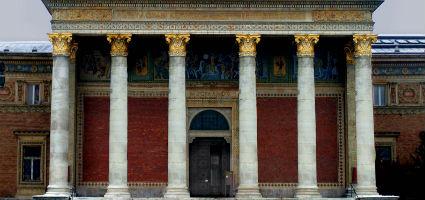2025. May 9. Friday
Kunsthalle - Budapest
 |
Address: 1146, Budapest Dózsa György út 37.
Phone number: (1) 460-7000, (1) 363-2671
E-mail: info@mucsarnok.hu
Opening hours: Tue-Wed 10-18, Thu 12-20, Fri-Sun 10-18
|
The exhibition has closed for visitors.
Museum tickets, service costs:
|
Ticket for adults
|
1200 HUF
|
|
|
Ticket for adults
(valid for the Kunsthalle and the Ernst Museum)
|
1400 HUF
|
|
|
Group ticket for adults
(from over 10 people)
|
800 HUF
|
/ capita
|
|
Ticket for students
(EU citizens from the age of 6 to 26 )
|
600 HUF
|
|
|
Ticket for students
(valid for the Kunsthalle and the Ernst Museum, 6-26 years of age)
|
700 HUF
|
|
|
Group ticket for students
(from over 10 people)
|
400 HUF
|
/ capita
|
|
Ticket for pensioners
(valid for the Kunsthalle and the Ernst Museum, 62-70 years of age)
|
700 HUF
|
|
|
Ticket for pensioners
(EU citizens from the age of 62 to 70)
|
600 HUF
|
|
|
Ticket for families
(1 adults + 2 children)
|
1800 HUF
|
/ family
|
|
Ticket for families
(2 adults + 2 children)
|
2400 HUF
|
/ family
|
Spending his childhood in the arboretum of Szarvas and the influence of his botanist father both played a role in András Balla’s decision to enrol in the landscape design programme of the University of Horticulture. He graduated from there with his first degree in 1970, which was later followed by his architectural studies. Thanks to his photos he has taken since the 1970s, he now has one of the most multi-faceted and diverse photographic oeuvres in Hungary. To quote László Beke’s apt description: “András Balla’s professions are horticulture and architecture, and his calling is photography.” The photos and photograms he produces using analogue processes range from experimental pieces and still-lifes to portraits, nudes and landscapes distinguished by a special choice of subjects, invention of form and solutions steeped in the artist’s exceptional talent for aesthetics. Besides his artistic activity, he took on an outstanding role in the Hungarian art scene through the establishment (1976) and organisation work of the Esztergom Photography Biennial. His thousands of photographs have been included in almost two hundred solo and even more group exhibitions, including the one held in the Ernst Museum in 1995. He is the author of numerous publications and the organiser of many photography events. He has been a regular member of the Hungarian Academy of Arts since 2012.

Visitors to András Balla’s exhibition in the Műcsarnok will be able to see a selection arranged into thematic units. There is a sense of resigned melancholy exuding from the artist’s images of transient, manless landscapes and the beauty of the world of man and objects. The photographer does not merely show us the visual starting points for his images but initiates us, at times with humorous associations, into a mysterious and mystical world by revealing the special aesthetic value hidden in even the most mundane objects and natural forms. The room devoted to his connected, coherent sequences is followed by his photo-novel featuring a hermit called Imre Borostyán, as well as his pictures of historic gardens (Versailles, Tivoli, Bomarzo) infused with an after-the-rain ambiance and, directly contrasted with these, his home garden milieus – verging on kitsch – people build for themselves using shells, garden gnomes antlers, awkward sculptures and knick-knacks. The third room pays a tribute to the Körösvidék (Crișana) with its manless floodplain landscapes. András Balla’s love of and respect for trees are manifest in the displayed panorama shots selected from the photographer’s earlier volume titled Menedék (Shelter), while besides the aestheticising forms of the complex patterns of branches, he uses dark, grim tones calling attention to the vulnerability of nature and the dangers of upsetting nature’s balance.
Marianna Mayer

Visitors to András Balla’s exhibition in the Műcsarnok will be able to see a selection arranged into thematic units. There is a sense of resigned melancholy exuding from the artist’s images of transient, manless landscapes and the beauty of the world of man and objects. The photographer does not merely show us the visual starting points for his images but initiates us, at times with humorous associations, into a mysterious and mystical world by revealing the special aesthetic value hidden in even the most mundane objects and natural forms. The room devoted to his connected, coherent sequences is followed by his photo-novel featuring a hermit called Imre Borostyán, as well as his pictures of historic gardens (Versailles, Tivoli, Bomarzo) infused with an after-the-rain ambiance and, directly contrasted with these, his home garden milieus – verging on kitsch – people build for themselves using shells, garden gnomes antlers, awkward sculptures and knick-knacks. The third room pays a tribute to the Körösvidék (Crișana) with its manless floodplain landscapes. András Balla’s love of and respect for trees are manifest in the displayed panorama shots selected from the photographer’s earlier volume titled Menedék (Shelter), while besides the aestheticising forms of the complex patterns of branches, he uses dark, grim tones calling attention to the vulnerability of nature and the dangers of upsetting nature’s balance.
Marianna Mayer
